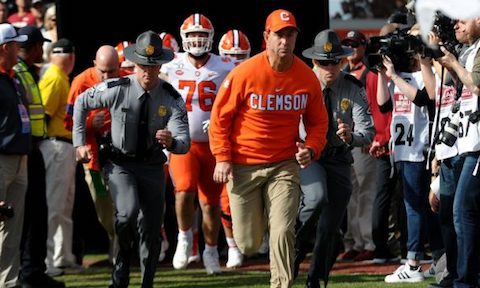College football is a lot like life. Programs are either elite or mediocre, and it’s easier for the elite to become mediocre than it is for the mediocre to become elite.
Dabo Swinney did things the hard way. Midway through the 2008 season, Swinney took over as Clemson’s head coach, and from day one, had the vision of someday establishing a winning culture similar to what Nick Saban has created at his alma mater, Alabama. Less than a decade later, not only did he mirror that persona, but he also turned it into Clemson’s identity.
Over the past five seasons, that identity has led to accomplishment after accomplishment. The memorable run started in 2015 when Swinney’s team started as the AP preseason No. 12 before making a run into the College Football Playoff National Championship, where they lost to Alabama. Little did anyone know, that loss would be a turning point for the program.
Since then, the Tigers have won 69 of 73 games, including the past 29, but they are hoping to clinch their second straight championship and third in the College Football Playoff era when they face LSU on Monday night.
For quite a few years, though, Clemson was a middle-of-the-road program nobody really paid attention to. In 10-plus seasons with Tommy Bowden as head coach, the Tigers were 72-45 and won three of eight bowl games, but wasn’t able to break through and become an elite program.
The Dabo Effect
When Swinney was hired, that changed. Slowly but surely, Clemson became a destination for the country’s top recruits and Swinney became known as an elite coach in college football.
Tajh Boyd was the first splash in the water. Also drawing interest from other power-five schools like Oregon, Ohio St. and Penn St., the quarterback committed to the Tigers in January 2009, giving Swinney his first five-star recruit as head coach. Nonetheless, there were rumors that Swinney’s job security was in jeopardy a year later, but the then-Clemson athletic director Terry Don Philips was adamant that he was a crucial part of the future of Clemson football.
Shortly after receiving approval from his boss in 2010, Swinney promised fans that the Tigers were about to have the best decade in program history, which he has delivered on, but in doing so, has been a reminder that recruiting is the most important route to success in college sports. And beginning with the Boyd breakthrough, some of the head coach’s biggest accomplishments have come as he has prepared for the future.
Recruiting their way to the top
While Boyd was one of four five-star recruits in 2009, Clemson’s 2014 recruiting class can be seen as the turning point in the Swinney era. Highlighted by Deshaun Watson, who was the nation’s top quarterback of the class and the Tigers’ first five-star recruit since the turn of the decade, according to Rivals.com, this group gave Clemson the boost it needed to get over the hump and become a premier college football program.
Since then, the Tigers have attracted multiple five-star players each year, totaling 17 in the past five classes, per Rivals. Looking toward the class of 2020, the site says they have the best group of players coming in. So far, they have received an NCAA-best six commitments from five-star recruits, one of whom is D.J. Uiagalelei, who Rivals ranks as the No. 1 quarterback in the nation.
Uiagalelei is the third to quarterback ranked top-two in his class to commit to Clemson since 2017, the site says — the others being Trevor Lawrence and Hunter Johnson.
But in the recruiting process, it seems that the Tigers don’t get caught up in bolstering the offense and ignoring defense. They instead have been able to get the players on both sides of the ball.
In that incoming class, they have signed 10 defensive players, four of which having five-star ratings, per Rivals. Plus, since the 2010 class, 14 of the 28 five-star players Clemson has signed have aimed to bolster the defense.
It’s all about the game plan
However, being able to recruit is only a portion of the battle. When it comes to game day, coaches have to put their plans and words into action, because at the end of the day, they will be judged on their team’s on-the-field performance, and Swinney has mastered this.
Different coaches have different ways of turning top recruiting classes into championship teams, but the majority of football teams are most successful when they don’t force players into their preferred schemes and instead alter their gameplans to their team’s abilities and limitations. But it seems that Swinney and his staff have mastered the process of recruiting the best players, regardless of their skill level, waiting to see who comes, and then adjusting the system based on each teams’ strengths and weaknesses.
So when they recruited Watson in 2014, for example, the Tigers weren’t concerned with how he’d fit into what they wanted to do. Instead, they knew his strength was passing the ball, so that’s what the offense revolved around. In 2015 and 2016, when it was quarterbacked by Watson, the team averaged 312.9 passing yards and 196.5 rushing yards per game, but in Lawrence’s two seasons, the offense has more balanced, averaging 285 passing yards and 247.7 rushing yards per game.
That said, it’s important to bear in mind that Lawrence has had a more dominant running back Travis Etienne — who has 3,668 yards and 48 touchdowns from scrimmage over the past two seasons — at his expense. Conversely, Watson had Wayne Gallman in the backfield, but it wasn’t the same. Gallman totaled 3,025 yards and 31 touchdowns in 2015 and 2016.
Again, because the passing game was a strength those two seasons, Swinney and his staff called more passing plays, and the opposite the past two seasons: a strong running game has meant a run-heavy offense. However, one of the biggest advantages to having Lawrence instead of Watson has been efficiency; under Lawrence, the Tigers have gained 7.5 yards per play, but with Watson, they were only picking up 6.3 yards per play, not to mention that defense has also been a strength for the Tigers of late.
They ranked top-10 in the country in total yards allowed, rushing yards allowed and points allowed per game last season, but improved this season and lead the nation in points allowed per game, total yards allowed and passing yards allowed.
Clemson’s rise can be an inspiration to programs who allow it to be. Each year, there are programs in the situation the Tigers were in, in 2008 — every day seems like groundhog day and mediocrity seems inevitable, — but Clemson is proof that there is hope. No, everybody doesn’t have Swinney waiting for the opportunity, but everybody is capable of searching for, and finding, their Dabo.




